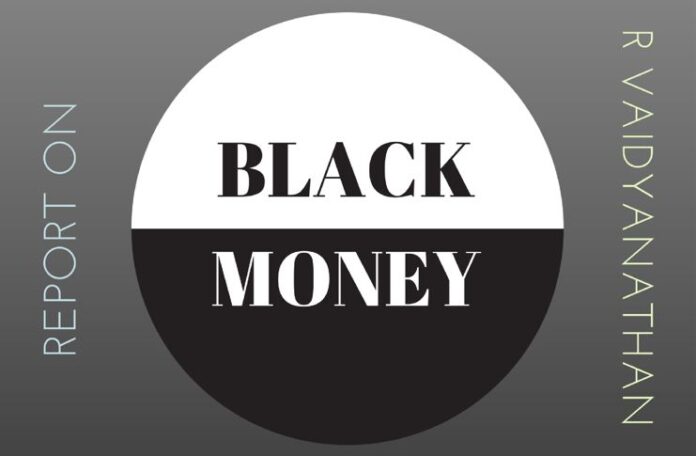
[dropcap color=”#008040″ boxed=”yes” boxed_radius=”8px” class=”” id=””]F[/dropcap]inance Minister of India Arun Jaitley declared that there is “No estimation of black money either before or after Nov 8” according to Indian Express. Being a lawyer perhaps he is finding out that he is out of his comfort zone in the new Avatar of a Finance Minister (FM). He does not seem to have knowledge of history of work done by his own department.
Report of the Committee, Headed by Chairman, CBDT titled “Measures to Tackle Black Money in India and Abroad 2012” elaborates on the various estimates of black money by different experts.
Wanchoo Committee’s estimate
Direct Taxes Enquiry Committee followed the method adopted by Kaldor with suitable modifications. It estimated assessable non-salary income for the year 1961-62 at Rs. 2686 Crores ($393 million) and non-salary income actually assessed to tax to be of the order of Rs. 1875 Crores ($275 million). Accordingly, the income, which escaped income tax, was of the order of Rs.811 Crores ($119 million). This estimate of tax-evaded income required some adjustments because of exemptions and deductions allowed under the Income Tax Act. After making the rough adjustments, Wanchoo Committee found that “the estimated income on which tax has been evaded (black income) would probably be Rs.700 crores ($103 million) and Rs.1000 crores ($146 million) for the years 1961-62 and 1965-66 respectively”. “Projecting this estimate further to 1968-69 on the basis of percentage increase in national income from 1961-62 to 1968-69, the income on which tax was evaded for 1968-69 can be estimated at a figure of Rs.1800 crores ($264 million).”
Rangnekar’s estimate
Dr. D.K. Rangnekar, a member of the Wanchoo Committee, dissented from the estimates made by the Wanchoo Committee. According to him, tax evaded income for 1961-62 was of the order of Rs.1 150 crores ($168 million), as compared to Wanchoo Committee’s estimate of Rs. 811 crores ($119 million). For 1965-66, it was Rs.2350 crores ($344 million), against Rs.1000 crores ($147 million) estimated by the Wanchoo Committee. The projections of ‘black’ income for 1968-69 and 1969-70 were Rs.2833 crores ($415 million) and Rs.3080 crores ($451 million) respectively.
Chopra’s estimate
Mr. O.P. Chopra, a noted Economist, published a series of papers on the subject of unaccounted income. He prepared a series of estimates of unaccounted income (black income) for a period of 17 years, i.e., 1960-61 to 1976-77. Chopra’s methodology marked a significant departure from the Wanchoo Committee approach and as a consequence, he found a larger divergence in the two series from 1973 onwards when the income above the exemption limit registered a significant increase. The broad underlying assumptions of his methodology are:
- Only non-salary income is concealed;
- Taxes other than income-tax are evaded and the study is restricted to only that part of income which is subject to income-tax. Thus, tax evasion which may be due to (a) non-payment or underpayment of excise duty, (b) sales-tax,(c) customs duties, or (d) substituting agricultural income for non-agricultural income, is not captured;
- The efficiency of the tax administration remains unchanged;
- The ratio of non-salary income above the exemption limit to total non-salary income has remained the same; and
- The ratio of non-salary income to total income accruing from various sectors of the economy remains the same.
The crucial finding of Chopra’s study is that after 1973-74, the ratio of unaccounted income to assessable non-salary income has gone up, whereas the Wanchoo Committee assumed this ratio to have remained constant. As a consequence, after 1973-74, there is wide divergence between the estimates of Wanchoo Committee and those of Chopra. Chopra also corroborates the hypotheses that tax evasion is more likely to be resorted to when the rate of tax is comparatively high. His findings also support the hypothesis that increase in prices leads to an increase in unaccounted income. Further, he has given a significant finding that funds are diverted to non-taxable agriculture sector, to convert unaccounted (black) income into legal (white) income. Chopra’s study estimated unaccounted income to have increased from Rs.916 crores ($134 million) in 1960-61, i.e. 6.5% of Gross National Product (GNP) at factor cost, to Rs.8098 crores ($1.19 billion) in 1976-77 (11.4% of GNP).
NIPFP Study on Black Economy in India
National Institute of Public Finance and Policy (NIPFP) conducted a study under the guidance of Dr.Acharya. The study defines ‘black’ money as aggregate of incomes which is taxable but which is not reported to tax authorities. The study, however, gives a broader definition of ‘black’ income and calls it as “unaccounted income” for purposes of clarity. As there is lack of sufficient data, the NIPFP study follows “the minimum estimate approach” that is to say, not being able to ascertain the most probable degree of under-declaration or leakage, the study uses a degree of under-declaration which could safely be regarded as the minimum in the relevant sector. In several cases the study has also made use of a range rather than a single figure of under-estimation. 4.14 While preparing the estimate of ‘black’ income, the study excludes incomes generated through illegal activities like smuggling, black market transactions, acceptance of bribes, kickbacks, etc. To prepare a global estimate of black income, the study confines itself briefly into six areas:
- factor incomes received either openly or covertly while participating in the production of goods and services;
- ‘black’ income generated in relation to capital receipts on sale of asset;
- ‘black’ income generated in fixed capital formation in the public sector;
- ‘black’ income generated in relation to private corporate sector;
- ‘black’ income generated in relation to export; and
- ‘black’ income generated through over-invoicing of imports by the Private sector and sale of import licenses.
After aggregating the different components of ‘black’ income the study quantified the extent of ‘black’ money for different years as under:
Table 1. NIPFP Estimate of Black Money in India 1975-1983
| Year | Estimate for Black Money (Rs. in Crore) | Percent of GDP |
| 1975-76 | 9,958 to 11,870 | 15 to 18 |
| 1980-81 | 20,362 to 23,678 | 18 to 21 |
| 1983-84 | 31,584 to 36,784 | 19 to 21 |
Source:http://www.incometaxindia.gov.in/Communications/Circular/910110000000000365.htm
The NIPFP study concluded that total black income generation of Rs.36,784 Crores ($5.4 billion) out of a total GDP at factor cost of Rs.1,73,420 Crores ($25.4 billion) was on the higher side, although it turns out to be less than 30 per cent of GDP as against some extravagant estimates placing it at 50 or even 100 per cent of GDP. The study suggested with some degree of confidence that black income generation in the Indian economy in 1983-84 was not less than 18 per cent of GDP at factor cost or 16 per cent of GDP at market prices.
While the NIPFP report estimated the ‘black’ economy (not counting smuggling and illegal activities) at about 20 per cent of the GDP for the year 1980-81, Suraj B. Gupta, economist, pointed out some erroneous assumptions in NIPFP study and estimated ‘black’ income at 42 per cent of GDP for the year 1980-81 and 51 per cent for the year 1987-88. Arun Kumar pointed out certain defects in Gupta’s method as well as in the NIPFP study. He estimated ‘black’ income to be about 35 per cent for the year 1990-91 and 40 per cent for the year 1995-96.
Agriculture black hole:
Believe it or not, income figures shared by the Income-Tax Department in response to an RTI application by a retired Indian Revenue Service official—Mr.Sharma– has revealed that agricultural income recorded an exponential increase from 2004 to 2013, touching a total of almost Rs.2000 lakh crores ($29.3 trillion) for individual assesses in 2011.
The agricultural income earned by the 6.57 lakh assessees who filed returns in 2011, at nearly Rs. 2000 lakh crores ($29.3 trillion), is over 20 times the country’s gross domestic product of over Rs. 84 lakh crores ($1.23 trillion) at the time, according to the Income Tax Department data shared under the RTI Act. Notably, agricultural earnings are exempt from Income Tax.
“The other possibility may be that illegal money or black money income is being laundered in a large scale and brought into the white economy. It requires deep investigation,” Mr. Sharma told The Hindu. He said the next date of hearing on his PIL plea was in April.
The earlier Government has requested NIPFP to conduct another study in 2012 about black money and that report too has not been released. But unofficial reports suggest that for the period 2008-09 to 2011-12 they have estimated that black money could constitute nearly 42% of total GDP or 71.5% of the “reported” GDP. They have indicated about mining /education sectors and also diversion of Kerosene etc. They have also looked at Fuel used for transport –reported and possibly actual.
But the most intriguing and interesting part comes now.
Black money assessment reports can’t be disclosed, say institutes that conducted study . Replying to an RTI query, NIPFP and NCAER said they were not authorised to share the reports.
The reports on the quantum of black money held by Indians in the country and abroad cannot be made public, country’s two premier institutes that conducted studies on the ill-gotten wealth on the Finance Ministry’s directive have said. The UPA government had in 2011 asked three institutes –Delhi-based National Institute of Public Finance and Policy (NIPFP), National Council of Applied Economic Research (NCAER) and National Institute of Financial Management (NIFM), Faridabad — to conduct studies on black money.
The study reports of NIPFP, NCAER and NIFM were received by the Ministry on December 30, 2013; July 18, 2014 and August 21, 2014 respectively.
Replying to an RTI query, NIPFP and NCAER said they were not authorised to share the reports.
“Under the Terms of Reference (ToR) with the Ministry of Finance, we are not authorised to share the report without their concurrence. Such concurrence is not forthcoming and our agreement with the Ministry of Finance prohibits us from disseminating this report,” the NIPFP said in reply to the RTI application.
The NCAER, in its response, said: “The primary repository of the report is Central Board of Direct Taxes (CBDT), Ministry of Finance” and the matter of sharing it should be dealt by the government.
No response has been received so far from the NIFM, which also conducted a study.
Earlier, the Finance Ministry had declined to share the reports submitted to it by the institutes about three years ago.
“Information is exempt from disclosure under Section 8 (1) (c) of the RTI Act, 2005 as the study reports received from the three institutes are under examination of the government and the same along with the government’s response on these reports are yet to be taken to Parliament through the Standing Committee on Finance,” the Ministry had said.
The Section bars disclosure of information “which would cause a breach of privilege of Parliament or State Legislature”.
There is at present no official assessment on the quantum of black money in the country and abroad.
“The issue of black money has attracted a lot of public and media attention in the recent past. So far, there are no reliable estimates of black money generated and held within
and outside the country,” the Finance Ministry had said while ordering the studies in 2011.
The different estimates on the quantum of black money range between USD 500 billion to USD 1,400 billion. A study by Global Financial Integrity estimated the illicit money outflow at USD 462 billion.
The Terms of Reference (ToR) for the studies included assessment or survey of unaccounted income and wealth and profiling the nature of activities engendering money laundering both within and outside the country.
The purpose of study was to identify, among others, important sectors of the economy in which unaccounted money is generated and examine the causes and conditions for it.
Source: [http://indianexpress.com/article/business/economy/black-money-assessment-reports-cant-be-disclosed-institutes-4464555/]
As usual our MPs are ignorant about any such studies and more interested in shouting.
The moot question is why is our FM so much worried about releasing the reports? Does it implicate any major leader of current dispensation or worried that his assertion about “no estimation” of black money will be disproved?
Obviously the Nation wants to know.
Note:
1. The conversion rate used in this article is 1 USD = 68.27 Rupees.
2. Text in Blue points to additional data on the topic.
- नकली खबर लक्षण है, बीमारी नहीं! - April 16, 2018
- Fake News/ Accreditation and Sedition - April 4, 2018
- Two Poisonous Seeds - March 15, 2018











The very fact that there are multiple reports which state the amount of black money itself shows there is no definite record of black money.Even forgetting the fact that 2012 is already 5 years ago and many changes would have taken place since then,All the reports are just estimations and not facts.So Jaitley is not necessarily wrong in saying what he said
Respected Sir, Our present F.M is more interested in SELF promotion than attending to his work at the ministry,and also to ensure that his future is protected and safe if there is a change. He is none other than an ettaiappan waiting to destroy Modiji at the first available opportunity. I hope Sri Modiji wakes up to this major internal threat soon and destroys the ettaiappan. I enjoyed your step by step analysis of reports on Black money.Thanks for educating me with this voluminous information. Regards, Ganesh
30months have passed since these 3 reports have been submitted to government.Can a PIL be submitted to SC asking how long the public needs to wait to find out what these reports say on black money?Why should it be kept it under wraps?Mere domain knowledge is not enough to take on the crooks.Those fighting corruption needs to have rock solid legal knowledge as well as finance. So Who else but DrSwamy can take on crooks.but then we have plenty of educated buffoons questioning his intent
It is right to use conversion of USD rates according to year .
Conversion is to just get a perspective. For some numbers like lakhs may not make sense.
Not understood why many are overtly interested to know about quantity of existing black money at present or pre 8th Nov.If anything no one can vouch for such quantity as it is an unknown variable entity.And when a FM of the country discloses some figure it is definitely going to split hairs, challenged ,pushed into continued controversy.
Suffice it to know for common citizens that a parallel black economy was in existence adversely hitting the nation’s development which has been brought to its knees.If the Govt continues its battle with further steps against foreign stashed clandestine cash/property, gold, real estate, builders diligently,impounds recovered wealth and put it in national kitty, punishes all wrongdoers the purpose would be served.